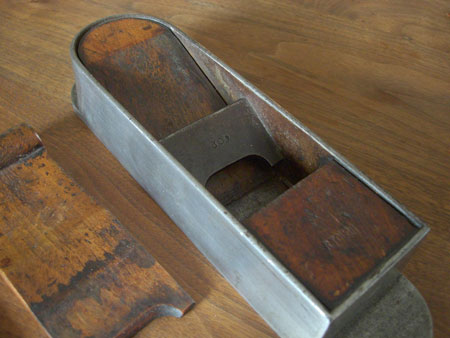 In part one of this series we discussed the earliest evidence of metal planes in Europe, that they were used for marquetry, and were not called yet called "mitre planes". In part one of this series we discussed the earliest evidence of metal planes in Europe, that they were used for marquetry, and were not called yet called "mitre planes".
In part two of this series we took a first look at early mitre plane production in England in the late 18th century.
Now let's take a quick look at some of the details of construction of the Gabriel mitre plane which highlighted part two. |
| The first thing that struck me about the Gabriel mitre plane is that, even though this plane is a very early example of the genre, it shares the same construction common to all English dovetailed steel mitre planes. It's 10 3/16" long overall (at the sole), 1 3/4" high, and 2 5/8" wide with a 2" iron by I. Sorby. The iron is certainly not original to the plane. |
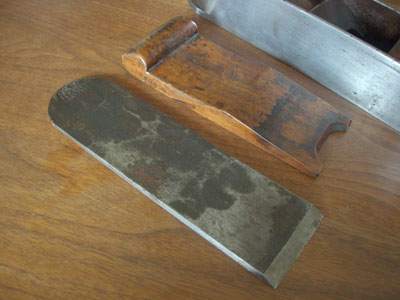 | The sole is made from blister steel and is rather thick, about 1/4" the sides are bent from much thinner, about 5/32" wrought iron. The metal stock would have been purchased already rolled out. The only tools that would have been used in its construction, aside from possibly bending the sides hot with a forge and anvil, and maybe doing the peening hot, would be a hand powered drill, metal cutting chisels, a hacksaw, and a myriad of files. In addition, to smooth the edges or the iron, a hard steel burnisher would have been used instead of abrasives. |
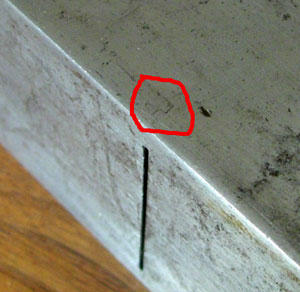 | The dovetails on this plane are not perfectly symmetric from side to side which suggests that the dovetails on the sides were laid out and cut before the iron was bent, and then the sole was laid out from the sides. The sole is made of two pieces of steel. A twenty degree slope was filed on the rear piece and and the front and rear are tongue and grooved together. The mouth is about 1/32" wide |
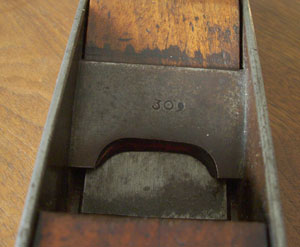 | A plain bridge was added and then the entire unit was assembled and peened together. By making the sides from soft wrought iron, and the sole from much harder blister steel the craftsman could ensure that most of the distortion to the metal happened to the sides, and the sole would not get dinged up and need extensive post peening work. Then the plane was infilled. |
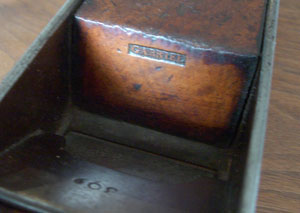 | The infill in this plane is beech, although most Gabriel mitre planes have rosewood infill. The front infill is simple unlike later mitre planes which usually have a molding which curves up from the sole to form an finger hold to make it easy to lift up the plane at the end of a stroke. On early infill planes, this plane being no exception the maker's mark has been stamped on the wood on the inside of the throat. This was probably done because at the time stamps were not hard enough to be continually used on metal. Later Gabriel mitre planes are stamped on the bridge. This plane like many of the dozen of so surviving Gabriel mitre planes is also stamped with a number (309) on the bridge. Nobody knows exactly why. They could be inventory numbers, manufacturing serial numbers, or something else. I will write more in the future about this curious feature but I still need to do more investigation. |
 Joel's Blog
Joel's Blog Built-It Blog
Built-It Blog Video Roundup
Video Roundup Classes & Events
Classes & Events Work Magazine
Work Magazine


 In
In 



I've been reading through a variety of 19th C marquetry books and alas, have yet to find a reference to a miter, mitre, block or any other plane that resembles this type. Toothing planes abound as do smoothers of various sizes. And lots of scrapers.
In checking some 18th C texts, I still can't find a reference, but then many refer simply to 'planes' without detailing what type.
It's a very frustrating search so far.
just look at 17th an 18th century sources. The ones I list. As soon as I can get a decent translation I will include what Felibien, Roubo, and Diderot say to accompany the illustrations I have already mentioned.
"The strike-block marked B3 is a plane shorter than than the Joynter, having its sole made exactly flat, and straight and is used for the shooting of a short joynt; because it is more handy than the long joynter. It is also used for the framing and fitting the joynts of Miters and Bevels; but the it is used in a different manner from other planes: for if the miter and bevel you are to fit be small, you must hold it very steddy in your left hand, with the sole of it upwards, and its fore-end towards your right hand: and you must hold your work in your right hand very steddy: Then apply the sawn miter, or sawn bevel at the end of your stuff, to the fore-end of the strike-block and so thrust it hard and upright forwards till it pass over the edge of the iron, so shall the edge of the iron, with several of these thrusts continued, cut or plane off your stuff the roughness that the teeth of your saw made..."
I'm sorry Joel, but I think you're barking up an empty tree. The strike block and the wooden miter plane were in use long before the infill miter plane. Both had issues and the infill miter plane was a natural evolution from the earlier British planes as plane makers sought alternative materials to overcome the structural problems or clearance issues of the wooden miter plane or the strike block plane.
Basing a whole theory of evolution of infill planes on a single image from Roubo is nuts; especially when you aren't fluent in French, don't have a translation and actually have no idea what the text of the book says.
I have constantly mentioned three sources not one. I have translated the accompanying texts I just want to get better translations before I post them. And there are no primary sources that contradict my references. Neve, Moxon, and a few others only mention strike block planes.
While I don't think there is any argument about the long existence of a strike block plane please tell me where you have primary evidence of something called in English a "wooden mitre plane" before 1790?